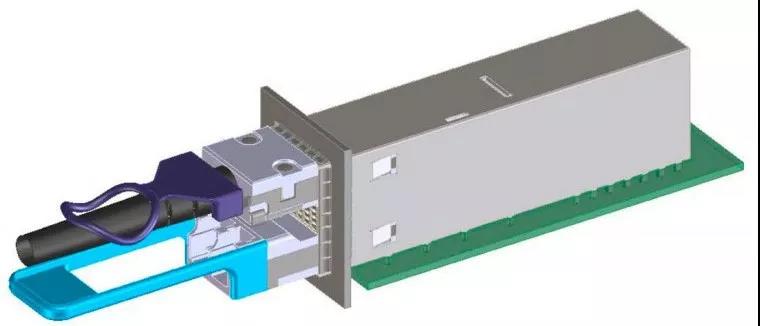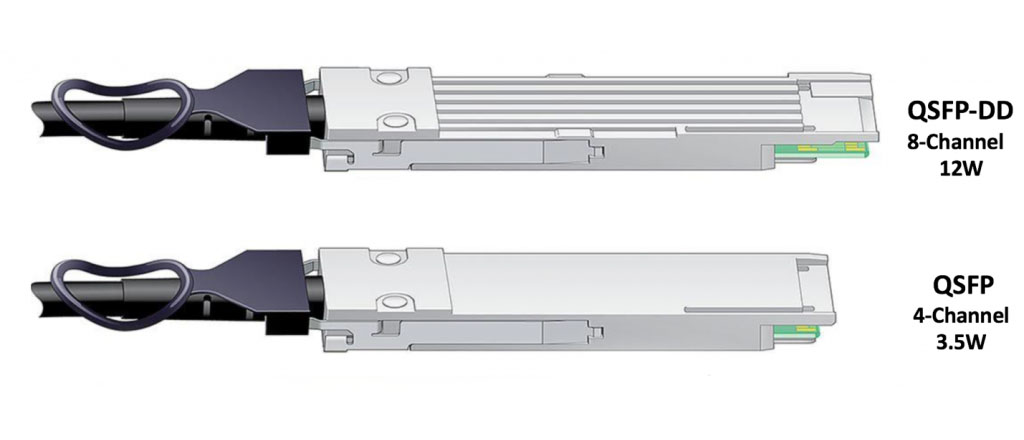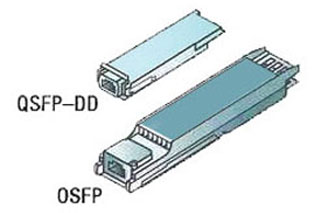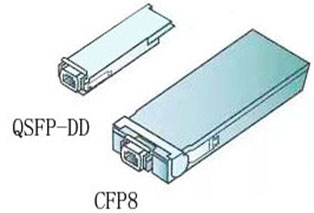

 Knowledge Base +
Knowledge Base +  2024.01.16
2024.01.16QSFP-DD(Quad Small Form Factor Pluggable-Double Density) is a high-speed pluggable module package defined by the QSFP-DD MSA team, and is the first choice for 400G optical module packaging. Enable data centers to efficiently grow and scale cloud capacity as needed.
QSFP forward and backward compatible, compatible with existing QSFP28 optical modules and AOC/DAC.
Using 8-channel electrical interfaces with rates up to 25Gb/s (NRZ modulation) or 50Gb/s (PAM4 modulation) per channel, providing solutions up to 200Gb/s or 400Gb/s aggregation. QSFP-DD enables aggregate bandwidth of up to 14.4Tb/s in a single switch slot.
With SMT(Surface-Mount Technology) connectors and 1xN cages, cage design optimization and module housing optimization achieve a minimum of 12w heat capacity per module.
Transmission media include passive copper (DAC), multi-mode fiber (MMF) and single-mode fiber (SMF).

bandwidth
Qsfp-dd offers up to ten times the bandwidth of QSFP+ or four times that of QSFP28.
The QSFP has four electrical channels, each with a rate of 10Gb/s(QSFP+) or 25Gb/s(QSFP28), aggregated to provide 40Gb/s or 100Gb/s solutions.
The electrical interface in the QSFP-DD pluggable package is available in 8 channels with rates up to 25Gb/s (NRZ modulation) or 50Gb/s (PAM4 modulation) per channel, with aggregate solutions up to 200Gb/s or 400Gb/s.
>>> To read more What are the advantages of the QSFP DD package How does it differ from QSFP+ QSFP28 QSFP56
compatibility
Qsfp-dd is backward compatible with QSFP+/QSFP28. Systems designed with QSFP-DD modules are backward compatible and support existing QSFP+/QSFP28 modules, providing flexibility for end users and system designers.
Port density
Qsfp-dd and QSFP+/QSFP28 have the same system port density. However, since each QSFP-DD port can accommodate eight channels instead of four, QSFP-DD doubles the number of ASIC ports it supports for existing interfaces such as CAU-4.

The mechanical interface of the QSFP-DD on the motherboard is slightly deeper than the QSFP+/QSFP28 to accommodate an additional row of contacts.
Compared with QSFP+/QSFP28, QSFP-DD is only a small increase in length to increase the bandwidth to 10 times /4 times that of the latter while maintaining the same port density, and it is also backward compatible, which means that customers can skip QSFP directly deploy QSFP-DD systems, reducing a lot of equipment costs.
>>> To read more CWDM SFP Wiki
The OSFP is a new pluggable package with eight high-speed electrical channels that will initially support 400Gb/s(8x50G).

dimension
OSFP is more than twice the volume of QSFP-DD.
compatible
OSFP is backward compatible with QSFP+/QSFP28 as is QSFP-DD, but requires an additional OSFP to QSFP adapter to implement it.
bandwidth
QSFP-DD currently only supports up to 400Gb/s, but OSFP can support up to 800Gb/s.
QSFP-DD is primarily for 400G networks that will be deployed on a large scale today (and 100G to 400G overused 200G), while OSFP is more likely to be for 800G networks in the future. Therefore, combined with the current situation, QSFP-DD as a 400G optical module package is more suitable.
The CFP family started with CFP, went to CFP2, to CFP4, and finally to CFP8.

dimension
The size of the CFP8 is significantly larger than the QSFP-DD, and the volume is more than three times that of the QSFP-DD.
(CFP series optical modules have always been targeted for carrier-grade applications, where port density requirements are not as high as in data centers.)
compatibility
None of the CFP series seems to be backward compatible. For CFP and CFP2 series optical modules, CFP to QSFP28 conversion adapters and CFP2 to QSFP28 conversion adapters have been available on the market for a long time.
bandwidth
Both CFP8 and QSFP-DD have a maximum bandwidth of 400Gb/s, but CFP8 only supports 400Gb/s(16x25G or 8x50G), while QSFP-DD supports both 200Gb/s(8x25G) and 400Gb/s(8x50G).
Subscribe to the newsletter
for all the latest updates.
2-5# Building, Tongfuyu Industrial Zone, Aiqun Road, Shiyan Street, Baoan District, Shenzhen. China
